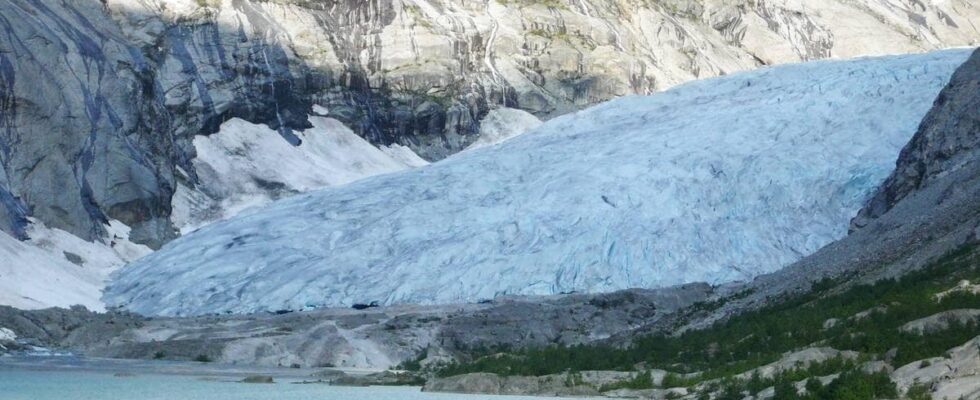– This year’s figures were quite special, a bit shocking for me as a glacier researcher to see such a large melting in one year. That’s what glacier researcher Liss Marie Andreassen at NVE says. It is particularly the measurements of the glaciers in northern Norway that make her use strong words. On two of the glaciers in the north – Langfjordjøkelen in Finnmark and Engabreen in Nordland – NVE has measured the thickness of the glacier. Aerial photo of Langfjordjøkelen in 2024. The glacier has become four meters thinner since last year. Photo: Turid-Anne Drageset and Bjarne Kjøllmoen / NVE Dramatically thinner And the result is dramatic. Both have lost four meters in thickness. That is four times as much as in a normal year. Langfjordjøkelen is around 50 meters thick. This means that it has become almost 10 per cent thinner in a single year. – We have never measured such numbers before on these glaciers. And there was simply extraordinary melting this year. Even though we knew the summer was very hot, says Andreassen. The Langfjord glacier in 2023 and 2000. All the glaciers back NVE makes two different measurements of the glaciers. They have measured the thickness of two in northern Norway, while they have measured the glacier fronts of 35 glaciers throughout Norway this summer. With the exception of one – the Stigaholt glacier, which has not moved – all have retreated. See an overview of all the glaciers at the bottom of the case. The Engabreen is the one that has retreated the most, with 83 metres. Over the past decade, the Engabreen has retreated almost half a kilometer (483 metres). – In southern Norway, too, the glaciers have decreased in thickness and melted back. So there is no good news this year, says Andreassen. The Bondus glacier in Kvinherad has retreated 54 meters since last year and 314 meters in the last decade. The pictures show how dramatic the development has been between 1886/87 and 2024. Then the glacier went far down into the valley, now it can just be seen up on the mountain. PHOTO: Axel Lindahl, Isaac Dawson/University of Leeds Tourist glacier “gone” One of the glaciers which has declined dramatically this summer is Nigardsbreen. It is a side arm of the Jostedalsbreen and is located in Luster. Nigardsbreen is perhaps Norway’s most famous glacier. It is located close to the Breheim Center and tens of thousands visit it every year. For years it has been possible to see the glacier up close from a car park. The glacier has retreated over 400 meters over the past ten years. This summer it retreated a further 42 metres. The result is that the glacier has become “disappeared” for the tourists. – At Nigardsbreen, we have had a photo spot in the inner part of the car park by Nigardsvatnet. This year we could no longer see the glacier front from there, says Andreassen. See the picture of Nigardsbreen before and now at the top of the case. – Now that the glacier front is no longer visible from this photo point, we have to create a new photo point. The tourists have to go further towards the glacier if they want to take pictures, she says. Going back many years, Glacier researcher Liss Marie Andreassen carried out measurements on Hellstugubreen in Jotunheimen this summer. The front of that glacier has receded 19 meters from last year. Photo: Solveig Havstad Winsvold / NVE This year’s decline comes on top of several decades of sharp decline for the Norwegian glaciers. In February 2022, NVE presented the first comprehensive overview of all glaciers in Norway since 2006. The overview showed that within 16 years, an area of glaciers the size of Mjøsa had disappeared. 20 glaciers had completely disappeared. – The glaciers are melting because of climate change. They are very sensitive to climate change and adjust their size by increasing or decreasing when the climate changes, says Andreassen. Temperature in Norway since 1900 compared to the average in the period 1991-2020 +1°C compared to normal? Click for explanation normal temperature1900192019401960198020002020Go to news’s Climate Status Why are most years blue and colder than normal? This is because all years are now compared to a new normal, that is, the average of weather i The 30-year period 1991-2020. These 30 years have been unusually warm. Most other years are therefore colder than normal. Until recently, researchers used a normal period that ran from 1961-1990. In these years it was relatively cold. It’s been quite a while since the 1960s and the new normal allows us to compare the weather with the climate (normal) that people actually experience today. The normal period is determined by the World Meteorological Organization (WMO), and is used in all countries . In this way, we can compare the weather in Norway with other countries and we can measure changes all over the globe. How can you calculate one temperature for the whole of Norway? There are many hundreds of thermometers located around Norway. These are read at fixed times and collected and checked by the Meteorological Institute. In some places the measuring stations are close together, in other places there is a greater distance. Using a statistical method, the meteorologists are able to give the measurements different weights, so that all parts of the country have equal importance: The country is divided into routes of 1*1 kilometer and the meteorologists then calculate one temperature for each route. Then they can again work their way up to one figure for the whole country, for a county, for a month or for an entire year. Published 28.11.2024, at 06.52 Updated 28.11.2024, at 08.38
ttn-69
Glacier researcher shocked by how much glaciers have melted this year – news – Climate

